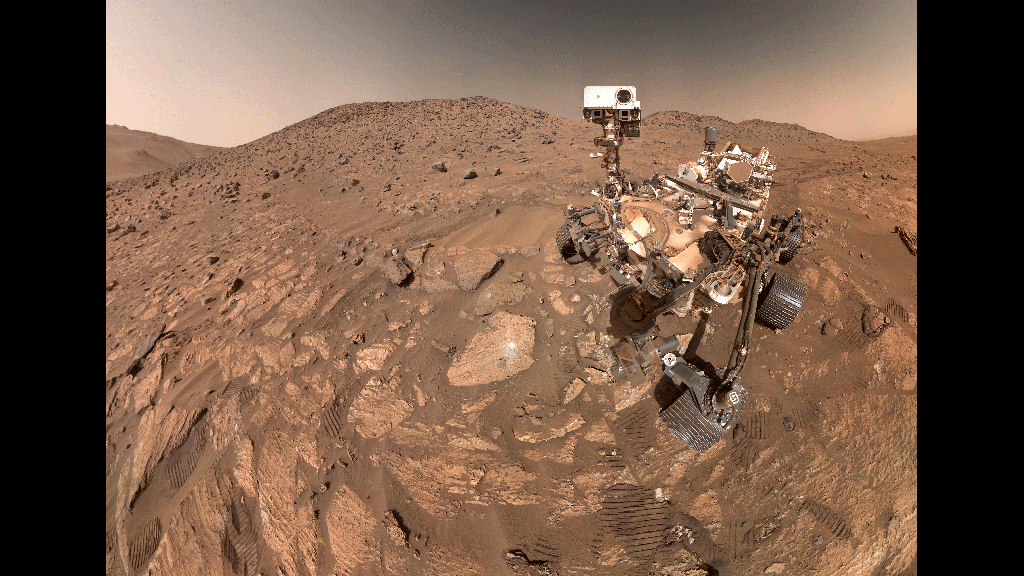Minerals
Extinct Volcanoes May Be an Untapped Source of Rare Metals
Unexplored iron-rich magma could help power current and future technologies
In Case Humans Go Extinct, This Memory Crystal Will Store Our Genome for Billions of Years
Scientists have created "a form of information immortality" meant to instruct future species on how to recreate humans. But who, or what, will find it?
How Large Gold Nuggets Form in Quartz Crystals During Earthquakes
Quartz, which can generate electricity, attracts large chunks of gold when stressed and squeezed by seismic shaking, according to a new study
Our Moon Was Likely Covered in a Magma Ocean Long Ago, and New Data From India's Lunar Rover Supports That Theory
Soil composition measurements from the Chandrayaan-3 mission reveal white rock called ferroan anorthosite, which would have floated to the surface in an ocean of magma
What Is the Secret Ingredient Behind Rembrandt’s Golden Glow?
Scientists found arsenic sulfide pigments in "The Night Watch," arguably the artist's most famous painting
Mars Rover Finds Three Possible Signs of Ancient Life on a Single Rock
Scientists were cautiously optimistic about Perseverance's discovery, though they indicated further research is needed before drawing definitive conclusions
Journey Into the Fiery Depths of Earth’s Youngest Caves
What Iceland's volcanoes are revealing about early life on our planet
Dentist Discovers Human-Like Jawbone and Teeth in a Floor Tile at His Parents' Home
Scientists are planning to study the specimen, embedded in travertine from western Turkey, in hopes of dating and identifying it
Ancient Iberians Ingested Red Dust Loaded With Mind-Altering Mercury
Bones in Spain suggest a mercury-rich mineral used for art and hallucinogenic trips poisoned a community 5,000 years ago
Tube of Ancient Red Lipstick Unearthed in Iran
New research suggests the nearly 4,000-year-old cosmetic may be among the oldest discoveries of its kind
French Tourist Finds 7.46-Carat Diamond at Arkansas State Park
Julien Navas plans to have the brown gem split into two pieces so he can give half to his fiancée and half to his daughter
Geologists Unravel the Mysteries of Australia's Rare Pink Diamonds
The dazzling, blush-colored gems likely emerged from Earth's mantle some 1.3 billion years ago, when a supercontinent named Nuna broke up, study suggests
Girl Celebrating 7th Birthday Finds 2.95-Carat Diamond
Aspen Brown stumbled upon the pea-sized, golden-brown gem while visiting an Arkansas park
How Cellphones Connect Us All
A new Natural History Museum exhibition explores how the devices link us to Earth and to a network of people worldwide involved in their supply chain
Five Places Where You Can Still Find Gold in the United States
Lucky for you, these gold rush hot spots have not yet run their mining course
This 12,000-Year-Old Wyoming Quarry Could Be North America's Oldest Mine
The state's archaeologists believe people quarried red ocher at Powars II starting 12,840 years ago
Minerals Used in Kitty Litter Could Help Fight Climate Change
A MIT study shows how, when treated with copper, a clay called zeolite can convert methane to carbon dioxide, a less powerful greenhouse gas
Treasure Hunter Unearths 2.38-Carat 'Frankenstone' Diamond
Adam Hardin discovered the impressive brown gem at an Arkansas state park
Black Lights Turn This North Carolina Mine Into a Psychedelic Wonderland
The Bon Ami Mine’s deposits of the mineral hyalite glow fluorescent green under ultraviolet light
Earliest Evidence of Mercury Poisoning in Humans Found in 5,000-Year-Old Bones
Researchers discovered the toxic element in remains buried across the Iberian Peninsula between the Neolithic period and antiquity
Page 1 of 3
:focal(3583x2560:3584x2561)/https://tf-cmsv2-smithsonianmag-media.s3.amazonaws.com/filer_public/4f/70/4f70ffc0-086f-4b51-9748-10dd4c9ed1db/pexels-blaremc-9496447.jpg)
:focal(1024x575:1025x576)/https://tf-cmsv2-smithsonianmag-media.s3.amazonaws.com/filer_public/5a/e2/5ae236c1-dbe7-48a0-9b08-03e71a9e2590/skynews-genome-5d-crystal_6689808.jpg)
:focal(1070x703:1071x704)/https://tf-cmsv2-smithsonianmag-media.s3.amazonaws.com/filer_public/f1/f0/f1f0d28b-c341-4086-a57f-09d9c9938f35/gettyimages-858519402.jpg)
:focal(800x602:801x603)/https://tf-cmsv2-smithsonianmag-media.s3.amazonaws.com/filer_public/07/9f/079f304b-c1e9-4f1f-8e4f-08cd8c46b768/volcanic_planet_5_r_1.png)
:focal(1150x865:1151x866)/https://tf-cmsv2-smithsonianmag-media.s3.amazonaws.com/filer_public/35/99/35996bd5-3624-4994-89fc-a0175f0718e4/de_nachtwacht.jpeg)

:focal(3024x2059:3025x2060)/https://tf-cmsv2-smithsonianmag-media.s3.amazonaws.com/filer_public/75/d6/75d6e62c-8117-4a36-8260-c01a3703b82c/jun2024_c03_lavatubes.jpg)
:focal(540x360:541x361)/https://tf-cmsv2-smithsonianmag-media.s3.amazonaws.com/filer_public/05/c5/05c5b0c8-2e9b-410e-bd2b-44fa17b8eaaf/found-a-mandible-in-the-travertin-floor-at-my-parents-house-v0-6rxgyqsizluc1.jpeg)
:focal(800x602:801x603)/https://tf-cmsv2-smithsonianmag-media.s3.amazonaws.com/filer_public/6d/50/6d500ceb-dcda-4d4d-bb98-6be98e49139a/montelirio-large-chamber-sprayed-over-skeletons-05_web.jpg)
:focal(926x697:927x698)/https://tf-cmsv2-smithsonianmag-media.s3.amazonaws.com/filer_public/3c/50/3c50268c-20f0-4a4f-83b9-e4a2c4ee62ea/lipstick_tube.jpg)
:focal(3000x2000:3001x2001)/https://tf-cmsv2-smithsonianmag-media.s3.amazonaws.com/filer_public/f4/da/f4daaaee-9542-4889-b983-9b3bd6464816/carinediamond02.jpg)
:focal(887x494:888x495)/https://tf-cmsv2-smithsonianmag-media.s3.amazonaws.com/filer_public/bd/36/bd36e96d-e421-465e-a0c8-3275ef7da7d6/web-7-crop.jpg)
:focal(767x416:768x417)/https://tf-cmsv2-smithsonianmag-media.s3.amazonaws.com/filer_public/1b/2c/1b2c13a6-b7e5-4b03-9a3c-d27256289c15/diamond_3.jpeg)
:focal(750x500:751x501)/https://tf-cmsv2-smithsonianmag-media.s3.amazonaws.com/filer_public/7c/6c/7c6ce995-6643-4d6c-897d-0eb7085fbbdf/nmnh-2023-01829.jpg)
:focal(1800x1200:1801x1201)/https://tf-cmsv2-smithsonianmag-media.s3.amazonaws.com/filer_public/3b/db/3bdbb9c9-07c7-486a-8ae0-0dc306abba4c/gettyimages-113280199.jpg)
:focal(960x722:961x723)/https://tf-cmsv2-smithsonianmag-media.s3.amazonaws.com/filer_public/1b/15/1b1570de-a14b-4f51-b8ef-e087e5d43210/cuevas-de-las-manos-pintadas-5068856_1920.jpg)
:focal(1061x707:1062x708)/https://tf-cmsv2-smithsonianmag-media.s3.amazonaws.com/filer_public/79/57/7957dd4f-b283-48fb-b79f-c53cc01a1b91/gettyimages-106887241.jpg)
:focal(550x309:551x310)/https://tf-cmsv2-smithsonianmag-media.s3.amazonaws.com/filer_public/6c/76/6c767159-afb1-46f0-9458-337d469e98cf/http___cdncnncom_cnnnext_dam_assets_220503135208-01-crater-of-diamonds-state-park.jpg)
:focal(1061x707:1062x708)/https://tf-cmsv2-smithsonianmag-media.s3.amazonaws.com/filer_public/bb/5d/bb5dda81-9d47-4a71-bcd3-00898ec0e621/gettyimages-988839604.jpg)
:focal(864x617:865x618)/https://tf-cmsv2-smithsonianmag-media.s3.amazonaws.com/filer_public/95/dc/95dcf32c-470d-444d-9bd7-695b26e89ec0/cinnabarit_01.jpg)